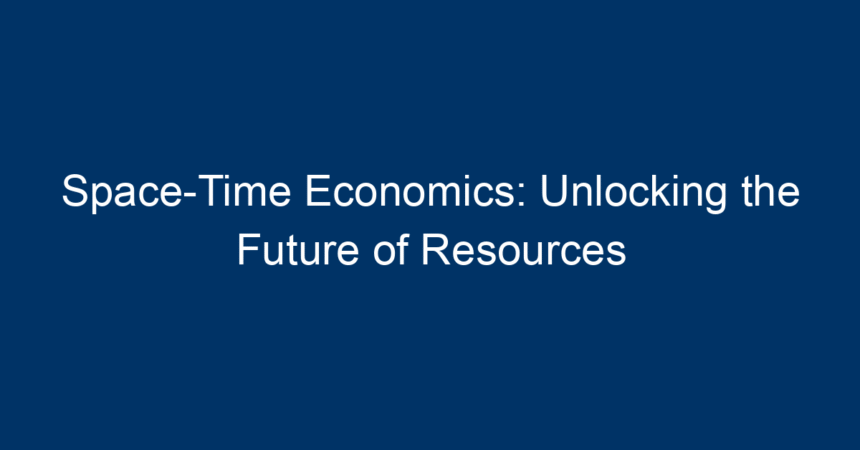In an ever-evolving world, the urgent need for innovative economic models has never been more pronounced. Enter space-time economics, a revolutionary approach that blurs the boundaries of traditional resource allocation by incorporating dimensions of space and time. As we stand at the crossroads of technology, sustainability, and social equity, understanding how space-time economics can reshape our perceptions and systems of resource use is vital. This article will delve into the principles of space-time economics, its implications for resource management, and actionable insights for leveraging this paradigm.
Understanding Space-Time Economics
What is Space-Time Economics?
Space-time economics refers to an economic framework that analyzes resource allocation through the lenses of spatial distribution and temporal dynamics. It integrates geographical elements with time considerations to optimize the use of resources, thereby maximizing efficiency and sustainability. This approach recognizes that the traditional models often overlook crucial factors like proximity, timing, and the interdependence of various resources.
Historical Context
To grasp the significance of space-time economics, it’s essential to understand its roots. Traditional economic theories primarily focused on supply and demand, neglecting how the location and time of resource extraction, production, and consumption heavily influence market dynamics. As global challenges such as climate change and resource scarcity emerge, the inadequacies of these classical models have become glaringly evident. Thus, the inception of space-time economics marks a pivotal shift towards a more holistic understanding of economic behavior.
The Principles of Space-Time Economics
1. Spatial Efficiency
Spatial efficiency in space-time economics is about utilizing geographical proximity to reduce transportation costs, enhance accessibility, and minimize environmental impacts. This principle promotes localized production and distribution, thereby fostering regional economies and reducing carbon footprints.
Example:
Urban agriculture is a prime example where space-time economics promotes local food production, ensuring fresher produce while reducing transportation costs and emissions.
2. Temporal Dynamics
Temporal dynamics emphasize the significance of timing in resource allocation and consumption. Different resources yield varying benefits over time, and understanding these timelines can lead to optimized decision-making.
Example:
The energy sector exemplifies this principle. Investing in renewable energy sources like solar and wind becomes more viable when considering fluctuating energy demands and technological advancements over time.
3. Integration of Technology
Modern technology plays a crucial role in implementing space-time economics. Tools such as Geographic Information Systems (GIS) and big data analytics enable better decision-making processes by providing insights into spatial and temporal trends.
Example:
Smart city initiatives leverage real-time data to enhance urban planning, optimize traffic flows, and reduce energy consumption, demonstrating the integration of technology in space-time economics.
Implications for Resource Management
1. Sustainability and Environmental Impact
Incorporating space-time economics into resource management fosters sustainable practices by highlighting the interconnectedness of local and global ecosystems. Businesses and policymakers can make more informed decisions that account for long-term environmental health.
Case Study:
Sustainable forestry management employs spatial analysis to ensure that timber harvesting occurs at a pace that allows forest regeneration, balancing immediate economic needs with ecological sustainability.
2. Economic Inclusivity
Space-time economics encourages inclusive economic growth by focusing on equitable resource distribution. By considering geographical disparities and temporal needs, this approach can empower marginalized communities often overlooked in traditional economic models.
Example:
Implementing microfinance solutions in rural areas can uplift local economies by catering to the specific temporal and spatial needs of those communities.
3. Enhanced Urban Planning
Urban planners can leverage space-time economics to create cities that are more efficient, livable, and responsive to residents’ needs. By analyzing spatial data and population trends, planners can allocate resources effectively.
Example:
By studying mobility patterns, cities can design public transport systems that align with peak usage times, reducing congestion and improving service efficiency.
Practical Applications of Space-Time Economics
1. Supply Chain Optimization
Businesses can harness space-time economics to optimize supply chains. By analyzing the spatial and temporal elements of supply and demand, companies can streamline operations and enhance profitability.
Strategy:
Adopting just-in-time inventory systems can significantly minimize storage costs and improve cash flow while meeting customer demands more efficiently.
2. Smart Resource Allocation
Using modern technologies such as IoT (Internet of Things) devices, organizations can monitor resource usage in real-time, allowing for prompt adjustments based on spatial and temporal needs.
Example:
In agriculture, precision farming techniques utilize sensors to monitor soil moisture and crop health, ensuring optimal resource use and maximized yields.
3. Policy Development
Governments can apply space-time economics principles to create responsive policies that address resource allocation, environmental protection, and community wellbeing.
Example:
Developing transportation policies that consider not just the current needs but also future growth projections can ensure sustainable urban development.
Actionable Insights for Individuals and Businesses
-
Embrace Technology: Invest in tools and technologies that provide spatial and temporal insights into your operations or lifestyle. Whether for route optimization or resource management, technology can drive efficiency.
-
Focus on Local: Consider the benefits of sourcing products locally. Localized supply chains often reduce carbon footprints and support community economies.
-
Educate and Advocate: Promote awareness about space-time economics within your networks. Advocate for policies that consider community needs through spatial and temporal lenses.
- Plan for the Future: Whether you’re a business or individual, think ahead. Analyze how trends may evolve in terms of resource use and adjust your strategies accordingly.
Conclusion
Space-time economics offers a transformative lens through which to view resource allocation and utilization. By integrating spatial and temporal considerations, we can unlock greater efficiency, sustainability, and equity in our economies. As the landscape of global challenges continues to evolve, adopting this innovative framework is not just advantageous; it is essential for creating a resilient future. By embracing the principles of space-time economics, we can pave the way for a more sustainable and equitable world.
As you begin to explore this dynamic approach, remember that every action counts. Engage with the principles outlined here to unlock the potential of space-time economics in your personal or organizational practices. The future of resources depends on our collective actions today.




